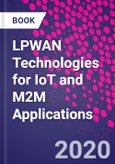Low power wide area network (LPWAN) is a promising solution for long range and low power Internet of Things (IoT) and machine to machine (M2M) communication applications. The LPWANs are resource-constrained networks and have critical requirements for long battery life, extended coverage, high scalability, and low device and deployment costs. There are several design and deployment challenges such as media access control, spectrum management, link optimization and adaptability, energy harvesting, duty cycle restrictions, coexistence and interference, interoperability and heterogeneity, security and privacy, and others.LPWAN Technologies for IoT and M2M Applications is intended to provide a one-stop solution for study of LPWAN technologies as it covers a broad range of topics and multidisciplinary aspects of LPWAN and IoT. Primarily, the book focuses on design requirements and constraints, channel access, spectrum management, coexistence and interference issues, energy efficiency, technology candidates, use cases of different applications in smart city, healthcare, and transportation systems, security issues, hardware/software platforms, challenges, and future directions.
Please Note: This is an On Demand product, delivery may take up to 11 working days after payment has been received.
Table of Contents
1 . Introduction to low-power wide-area networks 2. Design considerations and network architectures for low-power wide-area networks 3. LoRaWAN protocol: specifications, security, and capabilities 4. Radio channel access challenges in LoRa low-power wide-area networks 5. An introduction to Sigfox radio system 6. NB-IoT: concepts, applications, and deployment challenges 7. Long-term evolution for machines (LTE-M) 8. TV white spaces for low-power wide-area networks 9. Performance of LoRa technology: link-level and cell-level performance 10. Energy optimization in low-power wide area networks by using heuristic techniques 11. Energy harvesting-enabled relaying networks 12. Energy-efficient paging in cellular Internet of things networks 13. Guidelines and criteria for selecting the optimal low-power wide-area network technology 14. Internet of wearable low-power wide-area network devices for health self-monitoring 15. LoRaWAN for smart cities: experimental study in a campus deployment 16. Exploiting LoRa, edge, and fog computing for traffic monitoring in smart cities 17. Security in low-power wide-area networks: state-of-the-art and development toward the 5G 18. Hardware and software platforms for low-power wide-area networks
Authors
Bharat S Chaudhari Professor and Head, School of Electronics and Communication Engineering, MIT World Peace University, India.Dr. Bharat S. Chaudhari is working as a Professor (HAG) in Electrical/Electronics and Communication Engineering at MIT World Peace University, Pune, India. He graduated in Industrial Electronics Engineering from Amravati University in 1989 and received M. E. Telecom. E. and PhD (Engineering) from Jadavpur University, Kolkata, India in 1993 and 2000, respectively. He has previously held positions like Principal, Dean, and Professor at various Institutes in Pune. He is a recipient of the 2020 IETE N V Gadadhar Memorial Award, the MAEER Pune's Ideal Teacher Award 2015, and the Young Scientist Research Grant from the Department of Science and Technology, Government of India, in 2003. He was appointed as a Visiting Scientist (Simons Associate/Regular Associate) to Wireless Network Research Group, ICTP, Trieste, Italy from January 2007 to December 2020. He is a Senior Member of IEEE, Fellow of IETE, Fellow of IE (I), and a Founder Chairman of the IEEE Pune Section (2010 - 2011). He also chaired the IEEE Communications Society, Pune Chapter. He serves as a Program Evaluator of the Engineering Accreditation Commission (EAC) of ABET, United States, for accreditation of computer, communications, and similar engineering programs. His current research interest includes LPWANs, AIoT, TinyML, and Si-Photonics.
Marco Zennaro Research officer, Abdus Salam International Centre for Theoretical Physics, Trieste, Italy.Dr. Marco Zennaro is a Research Scientist at the Abdus Salam International Centre for Theoretical Physics in Trieste, Italy, where he coordinates the Science, Technology, and Innovation Unit. He received his PhD from KTH-Royal Institute of Technology, Stockholm, and his MSc in Electronic Engineering from the University of Trieste. He is a visiting Professor at KIC-Kobe Institute of Computing, Japan, and a Senior Member of IEEE and ACM. His research interest is in ICT4D, the use of ICT for Development, and in particular, he investigates the use of IoT in Developing Countries. He is TinyML4D Chair and Academic Network Co-Chair in the framework of the TinyML4D initiative. He has given lectures on wireless technologies in more than 30 different countries. More info here: https://www.ictp.it/member/marco-zennaro#biography








